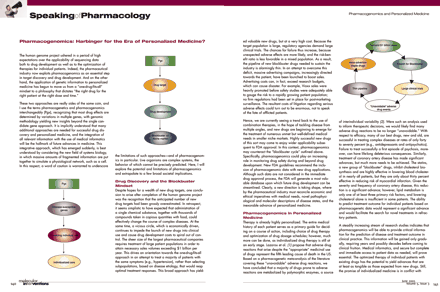Open Channels
- W. Ross Tracey, PhD, Associate Research Fellow
- Dept. of Cardiovascular and Metabolic Diseases, Pfizer Global Research and Development, MS 8220-3125, Eastern Point Road, Groton, CT, USA 06340, w.ross.tracey{at}pfizer.com
Dear MI:
I would like to compliment Wolfgang Sadée and Molecular Interventions for an interesting article in the June issue (Pharmacogenomics: Harbinger for the era of personalized medicine?
). However, I was surprised and disappointed by comments in the article about the pharmaceutical industry—the first being the implication that “massive advertising campaigns” serve solely to boost sales. In particular, I would take exception to the statement that “Advertising costs can, in fact, exceed research budgets….”
Why should I be concerned about these seemingly innocuous comments? I’m concerned not only because they are incorrect, but also because they are used routinely by self-proclaimed experts to unfairly criticize and demean the pharmaceutical industry. It is very easy to lose sight of the significant benefits advertising can bring to patients, such as providing information about treatment options and encouraging patients to inquire about the diagnosis of previously unrecognized disease when those patients visit their physicians. Moreover, advertising costs don’t even come close to exceeding research and development expenditures. In 2001, the major pharmaceutical companies (i.e., members of PhRMA) spent approximately $32 billion on research and development—more than did the NIH! This figure has undoubtedly increased in 2005, yet an alleged advertising figure, currently being used by media critics, is $4 billion per year—clearly a great deal of money, but still well below research and development expenditures even in 2001. A report published by the Government Accountability Office in 2002 put total promotional spending slightly higher, at about 2/3 of research and development spending; however, a full 50% of that figure was for free drug samples left with physicians, which both benefited their uninsured patients, and helped other patients determine whether a drug would work for them before having to purchase it.
I don’t believe Dr Sadée (or Molecular Interventions) intended to criticize the pharmaceutical industry. Nevertheless, our opponents would like nothing more than to refer to a publication in a scholarly journal, such as Molecular Interventions, to support their damaging rhetoric. These issues should concern all scientists, because if the views held of the pharmaceutical industry by many of the general public and elected officials do not change, the future of innovative drug discovery will be at risk.
The author responds:
- Wolfgang Sadée, Dr.rer.nat, Felts Mercer Professor of Medicine and Pharmacology
- Chair, Department of Pharmacology, Director, Program in Pharmacogenomics, Director, School of Biomedical Sciences College of Medicine and Public Health, Ohio State University, 5072 Graves Hall, 333 West 10th Avenue, Columbus OH 43210-1239, e-mail. sadee-1{at}medctr.osu.edu
In commenting on my recent article in Molecular Interventions, Ross Tracey brings up several issues that are indeed quite contentious and require much more discussion than is possible in a brief overview. The main point of contention is the expenditure for advertising relative to research and development. I concede that in most cases the latter exceeds the former. However, the point is that direct advertising to the patient has increased dramatically in the recent past. Dr Tracey argues that such advertising educates the public on treatment options and raises awareness of the risk factors for diseases, such as atherosclerosis—I fully agree with this view. On the other hand, one might argue that such advertising biases the patients towards specific mediations; indeed, studies have shown that a majority of physicians prescribe the drug demanded by the patient, a decision not necessarily made on the basis of unfettered information. Similar arguments can be made for free drug samples. As always, there are two sides to the coin. I agree with Dr Tracey that one should strive to present both sides even in a brief survey. My article was intended to stimulate discussions such as these—surely, we can all benefit from that.

- © American Society for Pharmacology and Experimental Theraputics 2005



